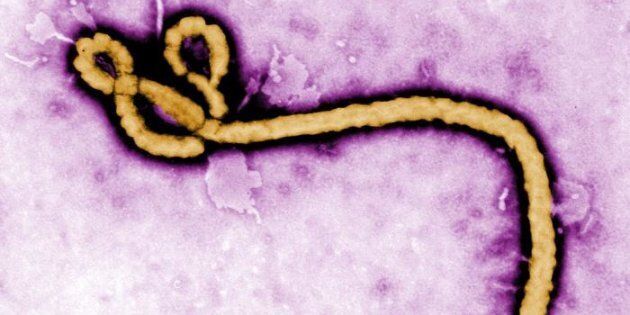
When it comes to infectious diseases, nothing strikes fear into the hearts and certain sphincter musculature of microbiologists more than Ebola. For the last 35 years, this particular virus has epitomized the stigma of the unseen killer that can spread like wildfire and leave its victims with no other option than to ensure their wills are signed and ready to be executed. In the public, however, apart from the gratuitous Hollywood fodder of the movie, Outbreak, the general understanding of Ebola is little more than an infamous micrograph.
Ebola virus, Public domain image from the CDC
To better appreciate the potential impact of Ebola and other infectious diseases, such as SARS, HIV, and pandemic flu, a University of Ottawa researcher has taken a look at a much more devious disease, which continues to spread worldwide with apparently no end in sight.
Bieber Fever.
Last week, the analysis of this incredibly chilling illness made headlines worldwide thanks to a chapter from the upcoming book, Understanding the dynamics of emerging and re-emerging infectious diseases using mathematical models. One of the authors, and in full disclosure my colleague, is mathematician and infectious disease modeler, Dr. Robert Smith? For those that are wondering, the question mark is part of his name to separate him from the other Robert Smith, who is ironically associated with making not a disease but The Cure.
Smith? used a highly complex mathematical set of formulas, known generally as the Susceptible-Infected-Removed (SIR) model to identify a specific number, called the basic reproductive ratio, or R. R is a measure of whether an infectious disease will spread, leading to an outbreak (R is greater than 1), or burn out and disappear (R is less than 1).
For well-known outbreaks, such as SARS, 1918 flu and even Ebola, R ranges between 2.2 and 8.6; these numbers can be considered dangerous to public health. By comparison, the R for measles, which is considered to be the most contagious infection, tops out at 18. Bieber Fever, however, has a ratio of 24. This means quite simply, it cannot be stopped.
When I asked Smith? to give me a better understanding of the malady in comparison to something more microbiological, such as Ebola virus, he put it this way:
"[Bieber Fever and Ebola] are diseases that seem like they should remain in tiny pockets (teen girls and remote villages, respectively), but with today's far more interconnected world, they have the potential to spread far beyond their origins."
In his chapter, Smith? proved this point by performing a counter study in which one simple factor of the equation was taken out: media attention. When this was removed, the infection dropped down to a non-threatening 0.59. As he puts it:
"The process of dealing with Bieber Fever is thematically very similar to dealing with something like Ebola: You need to identify the mechanisms of infection, what other factors are involved (the media vs. international travel), how your control efforts might play into the course of the disease and so forth."
One might argue that the control measures for Ebola and Bieber Fever could be simply reasoned without the need for complex mathematical equations. But for other diseases, such as HIV, tuberculosis and norovirus, where the means of spread are more complicated, including social behaviour, socioeconomic status and migration, effective control options may be far more difficult to identify and implement. By analyzing these diseases in the same way as Smith? has done in his chapter, potential solutions may be identified at a very low cost and without involving arduous clinical trials.
All of this is good news as we move into the future. While we may be inching closer towards a treatment for Ebola, and the media eventually tires of Justin Bieber, there is no doubt that they will be replaced by newer diseases that could use such mathematical analysis to control their spread. This may help us prevent oncoming menaces such as the ever-feared H5N1 pandemic; however, I worry that it's already too late to stop One Directionitis.